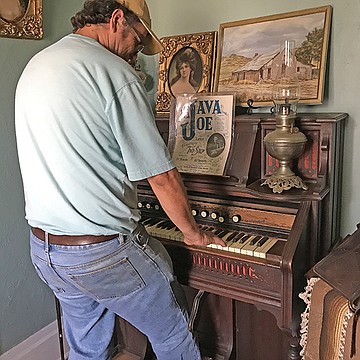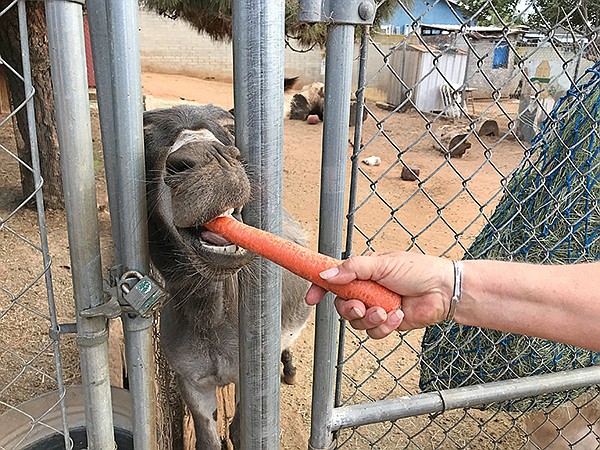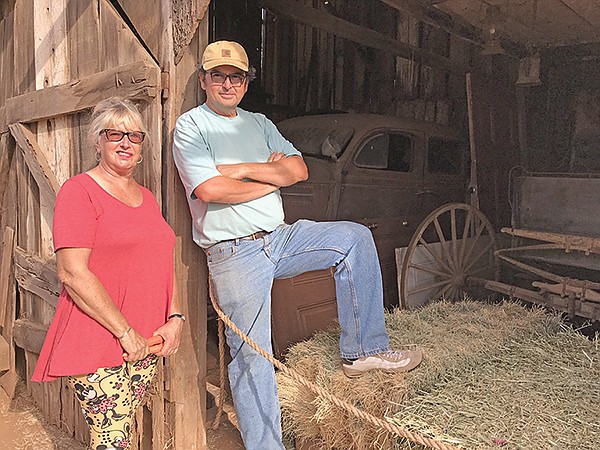 Facebook
Facebook
 X
X
 Instagram
Instagram
 TikTok
TikTok
 Youtube
Youtube

“Any ghosts?” I ask.
Chris Pro sits for a moment in the chair that Charles Stein himself sat in, back around 1900. Things are strangely quiet here in the parlor with its velvet table drapes and lanterns and old photos and grandfather clock. Who’d guess we were just down the road from noisy Highland and 18th?

It’s the Stein family’s farmhouse, the last original farm in National City, with animals and crops and orchards, and a complete butter-colored Victorian farmhouse with wrap-around porch, and tattered barn. Chris is the caretaker here.

“Ghosts? One, maybe,” he says. He’s winding up an ancient Victrola and putting a 78-rpm record on. Kay Kyser, “Ole Buttermilk Sky”. “The first six months, every night as I was snuffing out the last lantern upstairs, I’d hear someone walking along the side porch. Heavy, regular steps. The boards would creak. I’d come down and look and listen. Then I’d go out and check the gate. Nothing was ever disturbed.”
Uh, lantern? “I’m fanatical,” he says. “I don’t allow anything modern here. No TV, no electricity, only basic machinery, and my cellphone.”
He suspects Mr. Stein, the German immigrant and innovative farmer who lived here for 50 years, has been checking up on him.

Chris is an expert on the history of the place. Lori Anne Peoples, too. She’s sitting by the fireplace. She has long been president of the National City Historical Society, as well as a one-time elected City Clerk. She almost single-handedly saved the farm when developers were going to demolish it and put up apartment blocks, back in 1990.
“Yes, probably Mr. Stein,” she says.
“Uh oh, feeding time,” says Chris. We follow him back through the kitchen, still equipped with the Steins’ actual butter churn and the $100 wood-burning stove that Bertha Stein must have spent hours in front of. Chris starts gathering grain bowls, grain, and carrots. Lori Anne and I follow him out past a water hand pump, a 100-year-old Torrey Pine tree and an ancient wisteria vine, still flowering, whose leaves they use to sweeten water.
While Chris goes ahead, Lori Anne introduces me to Hopper, the Nigerian Dwarf Dairy Goat; Petey, his Miniature Nubian buddy; Chief, the Narragansett turkey and his Bourbon Red bride Pocahontas; two Kune Kune pigs from New Zealand, Rosy and Willa (Willa’s named after a beloved local cop); Ramona the hair lamb from Spain who sheds her own wool; Durango, the Sicilian donkey; Bobi, Fred, and Ethel, emus from Australia; Griffin and BunBun the bunnies; plus countless fruit, still on their trees, including brown turkey figs, black mission figs, Babcock peaches, and yellow plums. “Mr. Stein said you can grow anything in National City,” she says. “He’s right. It’s a pity the city’s built on top of such rich soil.”
On Saturdays, the farm’s open to the public, from 10 am to 2 pm. And plenty of children come, partly to earn community service hours. “We give the kids chores,” says Lori. “That includes scrubbing laundry on a washboard. And guess what? Boys love doing that way more than girls.”
And Chris’s ghost? The footfalls stopped after six months. “I guess old Mr. Stein decided I would take care of his house after all,” he says.


“Any ghosts?” I ask.
Chris Pro sits for a moment in the chair that Charles Stein himself sat in, back around 1900. Things are strangely quiet here in the parlor with its velvet table drapes and lanterns and old photos and grandfather clock. Who’d guess we were just down the road from noisy Highland and 18th?

It’s the Stein family’s farmhouse, the last original farm in National City, with animals and crops and orchards, and a complete butter-colored Victorian farmhouse with wrap-around porch, and tattered barn. Chris is the caretaker here.

“Ghosts? One, maybe,” he says. He’s winding up an ancient Victrola and putting a 78-rpm record on. Kay Kyser, “Ole Buttermilk Sky”. “The first six months, every night as I was snuffing out the last lantern upstairs, I’d hear someone walking along the side porch. Heavy, regular steps. The boards would creak. I’d come down and look and listen. Then I’d go out and check the gate. Nothing was ever disturbed.”
Uh, lantern? “I’m fanatical,” he says. “I don’t allow anything modern here. No TV, no electricity, only basic machinery, and my cellphone.”
He suspects Mr. Stein, the German immigrant and innovative farmer who lived here for 50 years, has been checking up on him.

Chris is an expert on the history of the place. Lori Anne Peoples, too. She’s sitting by the fireplace. She has long been president of the National City Historical Society, as well as a one-time elected City Clerk. She almost single-handedly saved the farm when developers were going to demolish it and put up apartment blocks, back in 1990.
“Yes, probably Mr. Stein,” she says.
“Uh oh, feeding time,” says Chris. We follow him back through the kitchen, still equipped with the Steins’ actual butter churn and the $100 wood-burning stove that Bertha Stein must have spent hours in front of. Chris starts gathering grain bowls, grain, and carrots. Lori Anne and I follow him out past a water hand pump, a 100-year-old Torrey Pine tree and an ancient wisteria vine, still flowering, whose leaves they use to sweeten water.
While Chris goes ahead, Lori Anne introduces me to Hopper, the Nigerian Dwarf Dairy Goat; Petey, his Miniature Nubian buddy; Chief, the Narragansett turkey and his Bourbon Red bride Pocahontas; two Kune Kune pigs from New Zealand, Rosy and Willa (Willa’s named after a beloved local cop); Ramona the hair lamb from Spain who sheds her own wool; Durango, the Sicilian donkey; Bobi, Fred, and Ethel, emus from Australia; Griffin and BunBun the bunnies; plus countless fruit, still on their trees, including brown turkey figs, black mission figs, Babcock peaches, and yellow plums. “Mr. Stein said you can grow anything in National City,” she says. “He’s right. It’s a pity the city’s built on top of such rich soil.”
On Saturdays, the farm’s open to the public, from 10 am to 2 pm. And plenty of children come, partly to earn community service hours. “We give the kids chores,” says Lori. “That includes scrubbing laundry on a washboard. And guess what? Boys love doing that way more than girls.”
And Chris’s ghost? The footfalls stopped after six months. “I guess old Mr. Stein decided I would take care of his house after all,” he says.
Comments